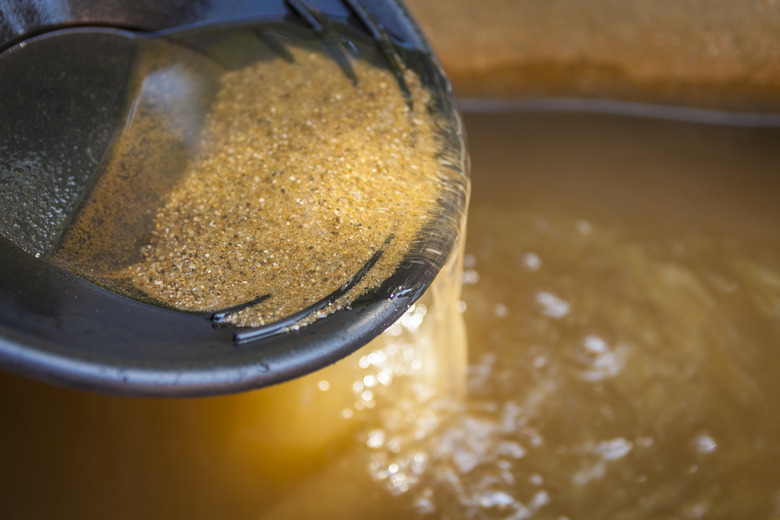How To Test A Rock For Gold
Gold feels heavy, like a lead fishing weight, when you hold a placer nugget in the palm of your hand. However, weight alone is not enough to identify real gold in a rock. As an amateur, you can test a rock for gold in several ways.
Simple Field Tests
Simple Field Tests
Many people confuse iron pyrite – fool's gold – with real gold. Simple field tests can help you identify whether you have found real gold. Fool's gold scratches glass whereas real gold does not. Iron pyrite is attracted to magnets, but real gold is not magnetic. Real gold also leaves a gold streak when scratched against a small bit of unglazed ceramic, like the back of a piece of bathroom tile, but iron pyrite leaves a greenish-black colored streak. In your gold hunting kit, a small magnet, piece of glass and a bit of unglazed tile can help you identify real gold in a flash.
Placer Gold
Placer Gold
Placer – also called nugget – gold is typically found by panning creeks, streams and rivers. If you hunt with a metal detector, you can find gold in dry stream beds. Some metal detectors have a feature that allows you to narrow the signal so that it only responds to gold, which helps when hunting in dry creek beds. In the pan, gold stays near the bottom or along the edge of a ridge because it is heavier than other rocks. It is malleable, which means it can be dented, and it has a brassy yellow color. This type of gold may even have quartz or other mineral material still attached to it.
Crush the Rock
Crush the Rock
California miners in the 1840s used sluice boxes to siphon gold from sand or crushed rock, and hobbyist gold miners use the same process today. Pulverize the rock by crushing it with a heavy mallet first, making certain to contain the bits. Put the material at the top of a sluice box and add water to push the rock down the slightly angled ridged slide. Gold typically collects within the ridges. Another option is to pan the pulverized rock to remove the rock from the pan and leave the gold.
Acid Test
Acid Test
Take a rock that contains gold in it – this process works best on quartz rocks – and set it inside a glass jar. Add white cooking vinegar to the jar, covering the entire rock and then some with the vinegar. The acid-based vinegar slowly dissolves the quartz crystals surrounding the gold, leaving only bits of quartz attached to the gold. Other more potent acids, such as those used in industrial settings, may work faster, but they require care and extreme safety measures when in use.
Hire an Assayer
Hire an Assayer
Before you stake a claim on a spot where you've found a possible gold mine, take a mineral sample to an assayer. Assayers analyze the entire metallurgical content of the rock, which can help you determine whether to file a gold claim on the location. Keep in mind that many rocks contain gold – just not enough to cover the cost of extracting it. The amount of gold per pound of rock indicates the value of the claim.
Cite This Article
MLA
Brenner, Laurie. "How To Test A Rock For Gold" sciencing.com, https://www.sciencing.com/test-rock-gold-4471786/. 13 March 2018.
APA
Brenner, Laurie. (2018, March 13). How To Test A Rock For Gold. sciencing.com. Retrieved from https://www.sciencing.com/test-rock-gold-4471786/
Chicago
Brenner, Laurie. How To Test A Rock For Gold last modified March 24, 2022. https://www.sciencing.com/test-rock-gold-4471786/
